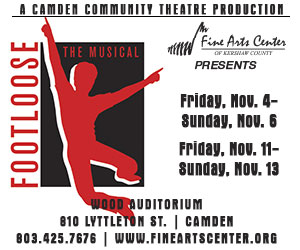Aaron Pelzek – Lighting Designer
By Alex Smith
One of the least visible, yet most integral positions in the theatre is that of the lighting designer. The theatre is an artistic medium that requires, in its fruition, the ability to both see and hear what is happening on the stage in order to fully comprehend what the playwright has written without looking at the page. Quite simply, without the work of the lighting designer, fully half of the theatrical experience would be missing.
Not yet thirty years old, Aaron Pelzek has designed lighting for some of Columbia’s most memorable local productions since he arrived to get his Masters’ Degree at USC almost seven years ago, productions that include The Illusion, The Cherry Orchard, Buried Child, and Cyrano de Bergerac at USC; and, Rent, Hair, Reasons to be Pretty, and Passing Strange at Trustus. Pelzek was born and raised in Milwaukee. He attended the Milwaukee High School of The Arts and began a paid career as a lighting designer while still an undergrad at age 19. After he received his Bachelor’s degree from the University of Wisconsin, he auditioned for grad school at the University/Resident Theatre Association’s unified auditions in Chicago, a process which, for designers, involves setting up a table with a resume and representative photos of one’s work to be perused by faculty from member institutions, who then decide whether or not to interview the designer for their graduate program. Of the fourteen schools Pelzek got interviews with, he was most impressed with USC’s theatre chair.
“I remember when Jim Hunter came to interview me in front of my set-up; he was the only one who didn’t blow smoke up my ass. He tore apart my set-up, in fact. He didn’t try to tell me what I could have done. He said, ‘this is terrible because…’” This quantification of technical shortcomings as opposed to subjective conjecture in regard to artistic choices was, Pelzek says, what ultimately drew him to study here.
“Some of the most important things I’ve learned came out of Jim’s and [design professor and head of USC’s Design MFA program] Nic Ularu’s mouths,” Pelzek says. “Nic always used to say, ‘You’ve got to go back to the beginning.’ At the time, that didn’t mean shit to me. ‘Go back to the beginning of what? The project? I don’t know what you mean!’ It took a long time, but now I know exactly what he meant. If you can’t discover the essence of what it is you’re doing, everything else is incorrect moving forward.”
The combination of stringent technical education and equal weight on introspection and core values and goals in regard to each project changed Pelzek’s view of how he defined his job as a designer. “Six years ago, I would have called myself a technician,” he says. “Now, I know I’m an artist. As long as you’ve developed a style and honed your skills so that you’re as good as your last show, then you’re an artist.”
In terms of process, he says, “The script is always the number one thing … although more often, now, I find myself more intrigued by [hearing] a director’s thoughts before I read a script. Too many times I’ve read the script first and ended up with a preconceived notion of a show that is not the show that the director winds up putting on the stage.” He laughs, “I’d rather hear a director’s interpretation of the script before I read it so I can picture the world they’re trying to create in my mind. The root of the system is: you are enhancing a director’s vision [for a show].”
Beyond the conceptualization phase of staging a show, the job of the lighting designer is working with the theatre’s master electrician to get the lamps hung from the theatre’s lighting grid, covered in sheets of colored gelatin, and focused on the stage. Depending on the size of the space, there may be anywhere from 48 to 250 individual instruments to physically adjust for each show.
The instruments are then run through dimmer packs, which allow them to be programmed into a control board, which has sliding switches that determine each lighting instrument’s brightness or dimness individually. Most boards allow the designer to use computer controls to create groups of lights that fade up and down together at the push of a button, and which are referred to as cues. Some shows have hundreds of these cues. These precisely controlled combinations of lights comprise the lighting design for a show, and they are constantly taking place directly over an audience’s head during the two hours they are watching a production.
The shape and form these cues take are best borne of a symbiosis between director and designer. “The lighting designer focuses the lights in these very specific patterns,” Pelzek says, thereby directing the audience’s focus and the action onstage. “The director’s job allows them to say to the lighting designer, ‘I want it brighter here, or more color here, so that in a sense they turn into the lighting designer. If you can’t switch roles that way with a director, it isn’t a collaboration.”
As complicated a process as lighting design is, amazingly, it is (along with the implementation of sound design) the final component to be added in rehearsals, usually days before a show opens. “There’s a huge responsibility. The lighting design is the last blitz.” The art of the lighting designer is preceded by, and built upon, the time and effort of every other person working on the show. It is a responsibility which Pelzek takes very seriously, and which he allows to require more of him than mere artistic choice when designing lights.
“To me, it’s not about process per show; it’s about the process of becoming a designer. I’m not saying you have to go get your MFA before you can be a lighting designer, but you’ve got to know the rules before you can break them.”






.jpg)
